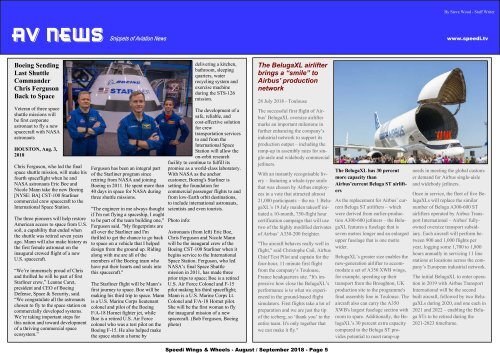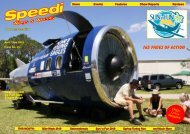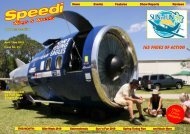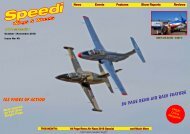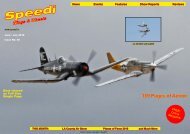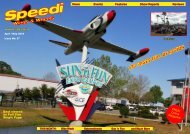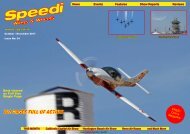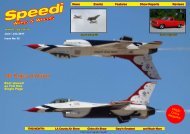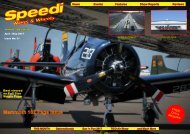You also want an ePaper? Increase the reach of your titles
YUMPU automatically turns print PDFs into web optimized ePapers that Google loves.
Speedi Wings & Wheels - <strong>August</strong> / <strong>September</strong> <strong>2018</strong> - Page 5<br />
By Steve Wood - Staff Writer<br />
Av News<br />
www.speedi.tv<br />
Boeing Sending<br />
Last Shuttle<br />
Commander<br />
Chris Ferguson<br />
Back to Space<br />
Veteran of three space<br />
shuttle missions will<br />
be first corporate<br />
astronaut to fly a new<br />
spacecraft with NASA<br />
astronauts<br />
HOUSTON, Aug. 3,<br />
<strong>2018</strong><br />
Chris Ferguson, who led the final<br />
space shuttle mission, will make his<br />
fourth spaceflight when he and<br />
NASA astronauts Eric Boe and<br />
Nicole Mann take the new Boeing<br />
[NYSE: BA] CST-100 Starliner<br />
commercial crew spacecraft to the<br />
International Space Station.<br />
The three pioneers will help restore<br />
American access to space from U.S.<br />
soil, a capability that ended when<br />
the shuttle was retired seven years<br />
ago. Mann will also make history as<br />
the first female astronaut on the<br />
inaugural crewed flight of a new<br />
U.S. spacecraft.<br />
“We’re immensely proud of Chris<br />
and thrilled he will be part of first<br />
Starliner crew,” Leanne Caret,<br />
president and CEO of Boeing<br />
Defense, Space & Security, said.<br />
“We congratulate all the astronauts<br />
chosen to fly to the space station on<br />
commercially developed systems.<br />
We’re taking important steps for<br />
this nation and toward development<br />
of a thriving commercial space<br />
ecosystem.”<br />
Ferguson has been an integral part<br />
of the Starliner program since<br />
retiring from NASA and joining<br />
Boeing in 2011. He spent more than<br />
40 days in space for NASA during<br />
three shuttle missions.<br />
"The engineer in me always thought<br />
if I'm not flying a spaceship, I ought<br />
to be part of the team building one,"<br />
Ferguson said. "My fingerprints are<br />
all over the Starliner and I'm<br />
thrilled to get the chance to go back<br />
to space on a vehicle that I helped<br />
design from the ground up. Riding<br />
along with me are all of the<br />
members of the Boeing team who<br />
have put their hearts and souls into<br />
this spacecraft."<br />
The Starliner flight will be Mann’s<br />
first journey to space. Boe will be<br />
making his third trip to space. Mann<br />
is a U.S. Marine Corps lieutenant<br />
colonel and pilot of the Boeing<br />
F/A-18 Hornet fighter jet, while<br />
Boe is a retired U.S. Air Force<br />
colonel who was a test pilot on the<br />
Boeing F-15. He also helped make<br />
the space station a home by<br />
delivering a kitchen,<br />
bathroom, sleeping<br />
quarters, water<br />
recycling system and<br />
exercise machine<br />
during the STS-126<br />
mission.<br />
The development of a<br />
safe, reliable, and<br />
cost-effective solution<br />
for crew<br />
transportation services<br />
to and from the<br />
International Space<br />
Station will allow the<br />
on-orbit research<br />
facility to continue to fulfill its<br />
promise as a world-class laboratory.<br />
With NASA as the anchor<br />
customer, Boeing's Starliner is<br />
setting the foundation for<br />
commercial passenger flights to and<br />
from low-Earth orbit destinations,<br />
to include international astronauts,<br />
scientists and even tourists.<br />
Photo info:<br />
Astronauts (from left) Eric Boe,<br />
Chris Ferguson and Nicole Mann<br />
will be the inaugural crew of the<br />
Boeing CST-100 Starliner when it<br />
begins service to the International<br />
Space Station. Ferguson, who led<br />
NASA’s final Space Shuttle<br />
mission in 2011, has made three<br />
prior trips to space; Boe is a retired<br />
U.S. Air Force Colonel and F-15<br />
pilot making his third spaceflight;<br />
Mann is a U.S. Marine Corps Lt.<br />
Colonel and F/A-18 Hornet pilot.<br />
She will be the first woman to fly<br />
the inaugural mission of a new<br />
spacecraft. (Bob Ferguson, Boeing<br />
photo)<br />
The BelugaXL airlifter<br />
brings a “smile” to<br />
Airbus’ production<br />
network<br />
28 July <strong>2018</strong> - Toulouse<br />
The successful first flight of Airbus’<br />
BelugaXL oversize airlifter<br />
marks an important milestone in<br />
further enhancing the company’s<br />
industrial network to support its<br />
production output – including the<br />
ramp-up in assembly rates for single-aisle<br />
and widebody commercial<br />
jetliners.<br />
With an instantly recognisable livery<br />
– featuring a whale-type smile<br />
that was chosen by Airbus employees<br />
in a vote that attracted almost<br />
21,000 participants – the no. 1 BelugaXL’s<br />
19 July maiden takeoff initiated<br />
a 10-month, 750-flight hour<br />
certification campaign that will use<br />
two of the highly modified derivates<br />
of Airbus’ A330-200 freighter.<br />
"The aircraft behaves really well in<br />
flight," said Christophe Cail, Airbus<br />
Chief Test Pilot and captain for the<br />
four-hour, 11-minute first flight<br />
from the company’s Toulouse,<br />
France headquarters site. "It's impressive<br />
how close the BelugaXL’s<br />
performance is to what we experienced<br />
in the ground-based flight<br />
simulators. First flights take a lot of<br />
preparation and we are just the tip<br />
of the iceberg, so ‘thank you’ to the<br />
entire team. It's only together that<br />
we can make it fly."<br />
The BelugaXL has 30 percent<br />
more capacity than<br />
Airbus’current Beluga ST airlifters<br />
As the replacement for Airbus’ current<br />
Beluga ST airlifters – which<br />
were derived from earlier-production<br />
A300-600 jetliners – the BelugaXL<br />
features a fuselage that is<br />
seven metres longer and an enlarged<br />
upper fuselage that is one metre<br />
wider.<br />
BelugaXL’s greater size enables the<br />
new-generation airlifter to accommodate<br />
a set of A350 XWB wings,<br />
for example, speeding up their<br />
transport from the Broughton, UK<br />
production site to the programme's<br />
final assembly line in Toulouse. The<br />
aircraft also can carry the A350<br />
XWB's largest fuselage section with<br />
room to spare. Additionally, the BelugaXL’s<br />
30 percent extra capacity<br />
compared to the Beluga ST provides<br />
potential to meet ramp-up<br />
needs in meeting the global customer<br />
demand for Airbus single-aisle<br />
and widebody jetliners.<br />
Once in service, the fleet of five BelugaXLs<br />
will replace the similar<br />
number of Beluga A300-600 ST<br />
airlifters operated by Airbus Transport<br />
International – Airbus' fullyowned<br />
oversize transport subsidiary.<br />
Each aircraft will perform between<br />
900 and 1,000 flights per<br />
year, logging some 1,700 to 1,800<br />
hours annually in servicing 11 line<br />
stations at locations across the company’s<br />
European industrial network.<br />
The initial BelugaXL to enter operation<br />
in 2019 with Airbus Transport<br />
International will be the second<br />
built aircraft, followed by two BelugaXLs<br />
during 2020, and one each in<br />
2021 and 2022 – enabling the Beluga<br />
STs to be retired during the<br />
2021-2023 timeframe.


